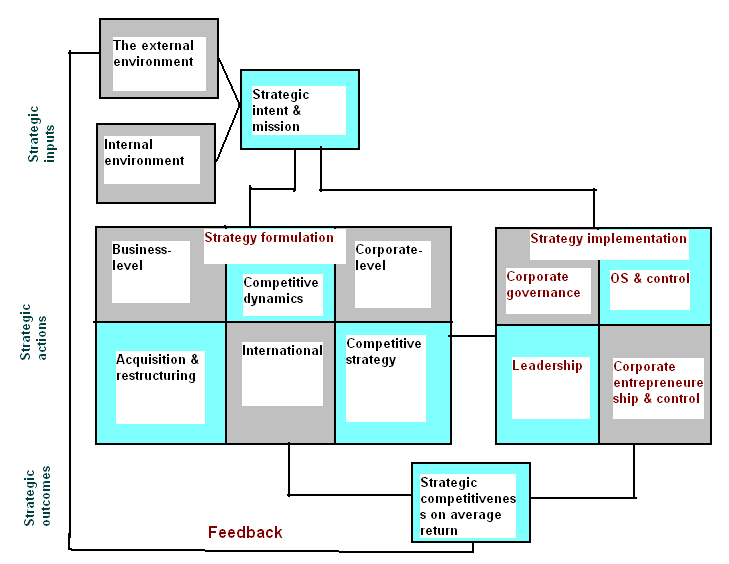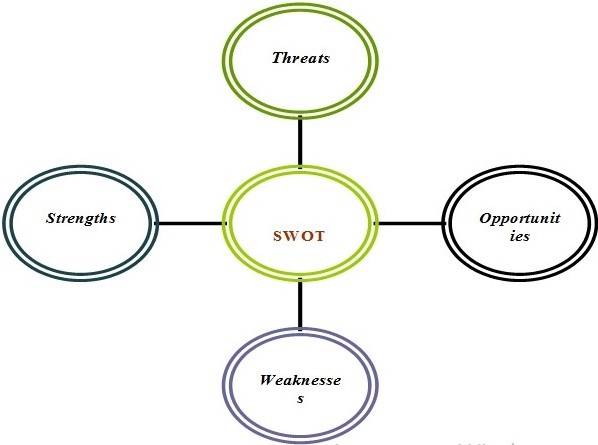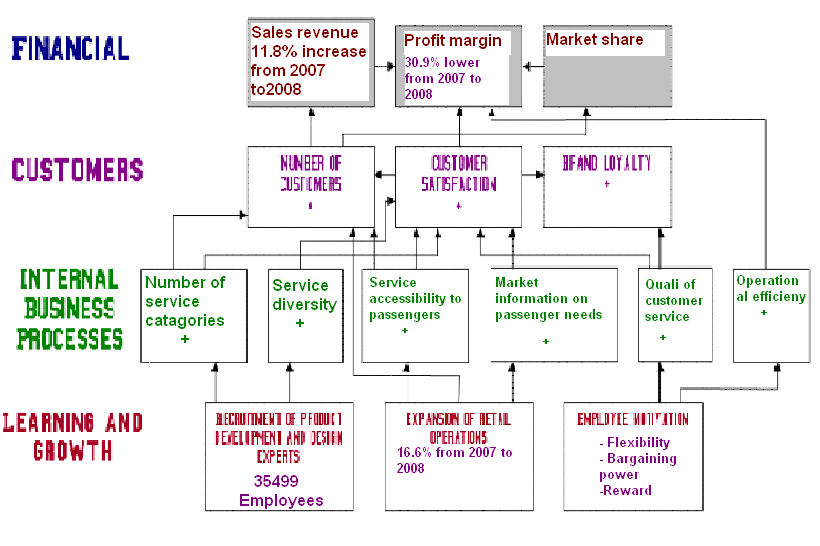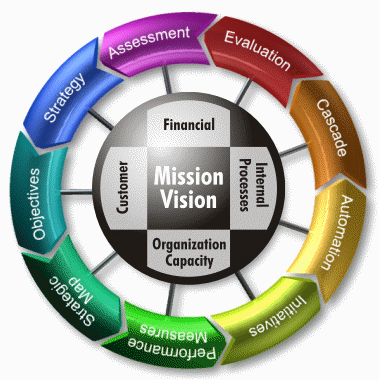Executive summary
The study is going to prepare on strategic analysis of “Southwest Airlines Co.” as the biggest passenger airways in the U.S.A as well as one of the prominent global players in the aviation industry. The analysis will start from the placement of present strategic options of the company especially emphasizing price, cost, human resource, and customer service, etc. issues. Here, an individual SWOT analysis will present the most prominent strengths, weaknesses, opportunities, and challenging factors faced by the company in executing the strategic operation. Next, a performance measurement tool named a balanced scorecard will propose by making a relationship composition between it and corporate strategies. Such combination will be focused on four major criteria related to finance, customers, internal business process, and growth factors, which are the main evaluation categories of the scorecard. Then, a justification of that approach in terms of company perspective will show constructed upon the issue of making a SMART scorecard concept. The performance measurement phase will make a comparative performance statement between 2007 and 2008 not only upon concrete visible amounts but also upon value perception of invisible aspects. A number of variables considering profit, service quality and accessibility, satisfactory rating, bonus, compensation, rewards, and other forms of employment condition, etc. will be measured within relevant category analysis of BSC. And finally, several suggestions will be made to clarify some fields where the company is facing some difficulty and threats along with possible solutions to face those crises. Therefore, after overcoming all the weakening issues through the adoption of wise decisions and reformatted strategies, it can be expected that Southwest Airlines would establish its position as the market leader in terms of the largest customer base and market share.
Strategic analysis
Southwest Airlines has been recognized as one of the largest airlines companies through the achievement of 3rd position within the global airline industry. The company has achieved such a place because of its huge customer base not within the country but beyond the world for which it has to adopt a number of general and differentiated strategies ranging from domestic business- level to international surroundings (Southwest Airlines 2008, ET AL 20). However, such broader criteria can show in a summed up concept, like:

Therefore, it can easily understood that the graph represents a complete version of general process of strategic management that involves a full set of obligations, decisions, and actions required for the airlines company for achieving competitiveness and upward- average returns that other market players (Hitt et al 6).
Enlightening with that structure, Southwest directs a number of strategic operations in terms of general, marketing, management, structural, competition, leadership, and taking over etc. In general, Southwest is highly affiliated for its lower cost tactics for obtaining leadership in airline functionality, charging of tickets and most importantly its database management system. Among all of those, the last year has shown a greater success of strategic implementation through a promotional initiative which is contributing for providing better customer service and forthcoming profit of the firm. Rather than offering “hub- and- spoke” service, it concentrates upon POP (point- to- point) service for generating greater straight routing. Such strategy has become fruitful in terms of reduction of connections, latency, and total journey time in terms of enabling nonstop flight to merely 78% customers. After that, Southwest uses comparatively easier formulation of fare, which is mainly less complex, less restricted timely and nearly accessible. In this regard, from 2007, the company has been offering a package of three types of fare as “Anytime”, “Business select” and finally “Wanna Get Away” for issue of giving customers the opportunity of selecting their preferred ones. Additionally, during the crisis of higher fuel prices, Southwest maintained a differentiation strategy by sustaining a price transparency through a campaign of no hidden fess by promoting via TV, radio, billboard and print medium. From mid- 2007, the company initiated an extended boarding technique to lessen customers’ waiting time at gate. It was an integrated automated process along with a long- run motto of delivering customized products and other encouragements. Besides, in 2008, it has introduced “extreme gate makeover” for improving both businesses oriented and family based in- flight functionality. In association with offering rapid rewards, Southwest offers credits to sell to corporate associates, like- hotels, credit card, and automobile rental agencies. During the same year, the company has launched a “Cashless Cabin” offer for having food and drinks without any pay while it is also concern about distribution of tickets through personal reservation, Sabre, online and professional travel agencies (Annual report 2008 22- 27).
Competition is another factor, which is in greater concentration of Southwest as the company is running in a highly competitive market. According to it, the vital competitive elements are price, expense, customer service, rate, and utility timetable, functional efficiency in association with selection and utilizing airplanes. However, from analytical viewpoint and four generic strategies of competition, Southwest Airlines basically follows integrated cost leadership/ differentiation approach by earning above- average rates of return which allows it for gaining competitive advantage by offering two forms of value to passengers in relation with differentiation and comparative lower cost (Hitt et al 172). According to Wiseth, Southwest is capable of drifting all of its functionality, which applies Oracle software for less complication and modernization. Such strategy is helpful for cost recognition and proactive technique which is helpful not only for corporate experts but for overall stakeholders (Para 29).
Southwest has introduced a special approach over the conversion channel for gathering informational inputs from present workforce. Here, an application of acknowledged specialists and Oracle oriented planning procedure is used that shows the company’s effort in research work before any strategic alteration (Annual report, 7- 8).
According to Annual report 2008, insurance is another strategic option that has used by the company for protection of assets, lease contacts, and credits. On the other hand, it follows seasonal operational structure casing quarterly incomes and profits (8).
For further strategic supervision, a SWOT (Strengths, weaknesses, opportunities, threats) analysis can be conducted which has discussed as below:

Strengths
Some stronger points of Southwest are:
- The company had experienced 1973 as the former success year that steadily expanded over time in an ultimate outcome of 1 million customers slightly after 3 years. Within 5 years, the company has enlisted by New York Stock Exchange with a wider reputation of satisfying passengers through pricing and environment.
- Initiation of vision, eloquence, and stability through on- time functionality and rewarding services;
- Differentiated motive through earlier discounts, without ticket and similar day freight offering services for becoming profitable and efficient management of customer utility (Hill et al 79).
- Major share of the company’s operational efficiency goes to its number of employees, as it is its internal belief that “employees come first, customers second”. In this case, it introduces an entertainment atmosphere within a hierarchical outline (Southwest Airlines 8).
- Perfect placement of perfect employees for delivering better customer service as a measure of maximizing shareholder’s benefits (Hill at al 87)
- Exclusive hiring methodology by initial screening, interviewing and pilot’s scope of hiring another pilot. Job functionality is highly considered here through imaginative corporate environment. (Hill et al 87)
- Vital price distinction from other competitors as in 2006, it had charged $104.40 much below than $416 for greater folk.
- Competent management team with an accomplishment of standard compensation policy for greater corporate value
- Achievement of economies of scale through LLC (low cost carrier) with Boeing 737 for keeping little maintenance costs and mass purchases (Hill et al 112).
Weaknesses
Some negative aspects are (Russell 3):
- Unsuccessful acquisition of Frontier Airlines in 2009;
- Congestive strategy has led to 15 markets out of providing service locally and indirect servicing internationally.
Opportunities
Few optimistic issues could be (Russell 3):
- The energy trading capacity of the company would be beneficial for long- run.
- The effort of utilizing secondary airports would further lower cost and raise convenience.
Threats
Overall threatening points would be (Southwest Airlines 29- 33):
- It has greater pressure from new lower cost competitors, especially JetBlue and United.
- Avoidance of actual business tactics of focusing a comprehensive market and low price captured by other players;
- The pricing approach of the company is also under pressure because of maturity of the market since JetBlue is also tying to gain the largest market share while Southwest is initially targeting budget- concerned passengers. Here, differentiation is becoming to tough requirement whether the company would generate the largest value for customers comparative to others.
- Cost of fuel would be hazardous for expansion and profitability as it has separated itself through hedging which was no longer been efficient because of a greater variation in fuel quantity and price in 2009 that would happen further also.
- Cost of labor is another challenging point as in stead of bargaining opportunity of employees is common here for which extra payment has to make which finally affects profit and growth. As Southwest is highly flexible of its personnel in terms of higher payment and rewarding issues from lower to higher level, it would be highly difficult for its own support in relation with competitor’s concession strategy.
Balanced scorecard of Southwest Airlines
A balanced scorecard is a strategic technique and management procedure, which is generally used in profit and non- profit corporations, industry, and government globally for lining up corporate functions in terms of strategic outlook, development of inner and outer communications and evaluate those tasks within the strategic mirror. The concept had developed by Drs. Robert Kaplan of Harvard Business School that can proposed to Southwest Airlines for possible adoption since it would be positively effective from company perspective in terms of measuring their overall strategic performance with a consideration of monetary and non- monetary issues within a conventional financial framework. It will also be effective in generating a “balanced” focus of the company that will provided to the execution and managing bodies. Additionally, the modified version of Scorecard system would shift Southwest’s various terms of strategic plans involving acquisition, e- business orientation, turnover, marketing, Volaris, employment benefits and marketing management into as smart as “marching orders” on a continuous basis. Ultimately, such structure will not only offer a traditional performance measurement but also a lead for a complete implementation scheduling (BSI, 1).
Further, such pattern of management procedure will allow Southwest Airlines for necessary amplification of their strategic vision, which will targeted to achieve final implementation. The feedback is also effective as a reflection of frequent strategic development as a complete transformation of literature theme to legitimate corporate concern. Therefore, after understanding the nature of balanced scorecard in terms of its related ingredients, it is now possible to draw a line where all of those theoretical strategies are accomplishing with Southwest’s external and internal corporate strategies by representing the following process flow-

All of aspects could discussed as below:
- Financial aspects: – The major elements of financial aspects of balanced scorecard has involved sales and operating revenue, expenses, margin income, net margin and income, shareholder’s equity, return on income, PRP, ASM and so one while by analyzing the recent corporate position of the company. It could argued that it has also to go forward with such issues as Southwest earn operating incomes, which generally consist of several sources like- passenger, freight and others. Similarly, the functional and other expenditure parts are highly influenced fuel cost, recent economic recession, additional services and modification, rewarding activities and continuous compensation planning which are greatly responsible for achievement of net profit and total market shares in relation with others. Several economic and operational parameters involving aviation taxes, Wright amendment, safety and health, environment, security, practice of customer service etc. could also be held liable for variation in overall financial picture (Annual report-2008 30- 35).
- Customer aspect: – As noted before, customer oriented itemization is in 2nd phase of scorecard. In this regard, Southwest can also make a sufficient level of self- comparison in terms of estimating different aspects of existing and forthcoming customer satisfaction and brand loyalty programs. In fact, it had already gained the crown of top customer satisfactory company in 1981 and 1987. 1 year later, it had achieved a combined award for this effort. Recently, it is exposing the cheaper flight services with sales promotion techniques like- discounting, traveling without ticket and little fare charge, faster turnover time, transparent pricing, credit facility under rapid rewards frequent flyer curriculum, cashless cabin, online booking service etc. All of these functions have closely related with possessing a larger customer base, which is mostly price sensitive.
- Internal business processes: – This part of the scorecard involves a quantification of projected products or services, product variety, product availability to customers, information system for calculating demand schedule of customers, superiority of intended service and functional efficiency. All of these aspects have closely related with various tasks that Southwest undertakes for dealing with publics inside and outside of the company. Such as, Southwest introduced the path of service diversification of being prominent at Love Field traveler segment through a better continuation of hanger, headquarters, instruction booth etc. Other requirements include online service for aiding people in visualizing schedule and root map as well as venture information, in-flight wi- fi, satellite oriented broadband and holiday packages involving internal roundtrip, hotel lodging and taxes, transportation facilities, rounding up of beautiful sites, full day assistance benefits and tourism protection plan etc. Numbers of services are offered through different categories covering not only general but also extra- ordinary themes popularly termed as Shamu, Silver one, Triple Crown One, spirit One, Maryland One, New Mexico One, etc. while it is well- known for incredible low pricing penetration strategy for practicing operational efficiency. In 2008, it had replaced the formal POS (point of sales) system with a newer one with a back office investment. Moreover, to maintain quality and customer interest, no ticket has sold through other online venues rather than personal site or phone with Web- only fare discount.
- Learning and growth: – Here, the original strategy encompasses on integrating adequate experts potential growth and development, operational expansion and finally, employee benefits and compensation planning. The company posed a technological growth for altering the ticket less procedure for increasing information flow for the motive of gaining additional functional efficiencies by changing of backward accounting process, payroll, and HR data flow within 2009- 2010. Southwest is one of the most significant companies that believe in flexible working environment aligned with various forms of share- based compensation plan, rewards and bonus while related experts are involved for managing assets (Annual report-2008, 28).
After evaluating the strategic relationship, several measures of the balanced scorecard can be justified by emphasizing on some certain issues before which a comprehensive criteria of the process can be viewed as:

The goal of a standard justification will show how much competency the company could extract for balancing long and short- run activities and calculating corporate and unit- wise achievement through an implementation of this card. This condition will also integrate the financial, inner functional, customization, and development approach of human resources within the firm. Money cannot be a single measurement tool for justifying the corporate condition on the scorecard by representing present or forthcoming performance factors like- quality, speed, small number of value addition services etc. while the last option of intellectual development places in priority. Similar to this option, internal integration of the company is also essential since without it, the BSC will be completely ineffective and generate no viable outcome. After specifying the central objective of strategic evaluation, further Southwest needs to understand the cause- and- affect drivers, which can be of 4 types, as:
- Environmental drivers, which exist beyond the company. Present government, security, atmosphere, passenger services, and international political forces are some of the illustrations within these drivers.
- Organizational drivers which generally exist inside of Southwest in terms of corporate strategy, structure and several policies, like- pricing, advertising, e- business, employee payment system etc.
- Unit or departmental drivers including service processing, unit relationship, assignment of liabilities etc.
- Individual drivers regarding management skills and caliber along with personality assessment,
Now, formatting a SMART (Specific, Measurable, Agreed Upon, Realistic, Time- bound) project can be required for justification of successful BSC equation, as:
Measurement * Technique* Control* Focused diligence* Agreement
- Measurement – Measuring the right things;
- Techniques – Use of either large- scale involving altering passengers or services, reformatting, strategic alteration or core competencies etc. or small- scale techniques on intended demand.
- Control: 4 rounds of actions are required from level 1 to 4 as control with an internal impact, control 2 with an external impact, control 3 of action driver and control 4 as similar previous one but non- action driver.
- Persistence – It involves project management regarding timing of each work by using PERT or Gantt chart.
- Consensus – In requires communication, planning and making decision, application of action and necessary recommendations.
Performance analysis
According to the basic rules of scorecard, financial performance of Southwest has measured between 2 fiscal years of 2007 and 2008 (Southwest Airlines 2- 58). Some other comparison issues would show as following:
Recommendations
The overall analysis of Southwest Airlines has revealed almost all issues that the company can represent on balanced scorecard model. Although it poses many positive scores, there are some defective propositions about which it should have special caution and possible correction (Annual report, 30- 33). Such as:
- Control of fuel costs: – Since volatility in fuel costs is greatly liable for increasing total operating expenditures of the company, it should adopt upgraded measures for making a correct hedging through an upgraded alternative strategy, efficient fuel management and ensuring adequate amount of supply are some steps that can taken to sustain a relentless operation.
- Maintenance of satisfactory employer- employee relationship: – It should pose more concern through sustaining over that relationship since it is highly labor concentrated which has mostly governed by labor unions. As Southwest has incurred about 32% of total expenses for employment benefit issue, by applying a positive but tricky concept, it should gradually try to lower such portion of expenses for cost efficiency.
- Timely and effective application of profits: – In this sector, Southwest Airlines should improve capability for timely implementation, conversion and keeping up necessary information system framework, balancing a realistic expenditure management and adoption of external support for such applications.
- Balanced dependence on technology and contingency planning: – As the company is going to be greatly technology oriented for operating maximum operational tasks, adequate security measures should accomplished in all those activities so that uncertainty technological breakdown couldn’t shock the entire system. It should also be careful from any domestic or international aggressive attack by a composition of a contingency plan.
- Employment caution: – The airlines company should be wiser enough in developing its human resources since it is a resource, which is merely preemptive in nature. Therefore, it requires an involvement of better-employed personnel who can best represent the company services to customers with a prior exposition of fun and enjoyment of each flight.
- Development of brand loyalty: – Southwest needs to work harder in changing many customers’ feeling of treating it as a second-class brand while it actually does some extra. Additionally, it needs to change the brand image of low price carrier for making a better competition by adding some additional benefits with existing service. To build better loyalty, it should provide fixed seats to customers.
- Conduction of marketing research: – In order to understand current market trend and thinking of customers about the company, it should arrange for conduction of yearly marketing research project. Such project would be fruitful enough for making strategic decision, understanding public demand, and measuring their loyalty level with necessary changes.
- Attending the programs of removing situational barriers: – Similar to various internal issues, the company’s growth and development possibly would highly affected by several external factors involving restricted airport capability, operational restriction in terms of imposition of new aviation law, restriction of certain marketing practices and complains from local community for creating noise pollution. Although these factors are uncontrollable by nature, but the Southwest could try to minimize it by participation some meetings or conventions demanding to lessen those barriers, keeping a good relationship with local government and community to having some sort of situational advantages as well as combined involvement in capability development programs of airport.
- Increase in service accessibility: – Since the company maintains a sole- supported distribution network, not all types of customers would always access it. Therefore, it should involve local travel agents more to enhance their service availability.
- Expansion of existing customer base: – As the recent competitive pressure is capturing many price sensitive customers as mostly targeted by Southwest, it should change the strategy of targeting only that segment rather than going through a mass marketing concept of segment diversification.
- Supply diversification: – As the company, only uses the brand of Boeing purchased directly from it or some little outsourcing, an uncertain inability or unwillingness of Boeing would be resulted in operating disaster for which it needs to secure and diversify its supply segment. Moreover, it needs to reform the existing insurance coverage policy to protect public image and lower costs.
Conclusion
Through an analytical review of Southwest Airlines, it is now easy to realize the zest strategic points of the company by using a measurement tool as balanced scorecard, which has clearly identified major factors necessary to perceive about actual corporate environment, personality, and passion. Although there are some difficulties, a planned supervision followed by timely implementation would reform it as a market leader.
Works Cited
BSI. Balanced Scorecard Basics. 2009. Web.
BSI. Building & Implementing a Balanced Scorecard: Nine Steps to Success. 2009. Web.
Hitt, Michael, Duane Ireland, and Robert Hoskisson. Strategic Management: Competitiveness and Globalization: Concepts & Cases. 8th ed. McGraw Hill. 2007. Web.
Kotler, Philip & Gary Armstrong. Principles of Marketing. Prentice-Hall Private Limited. 2006. Print (P.P. 249- 253, 210)
Malhotra, Naresh. Marketing Research- An Applied Orientation. Prentice-Hall of India Private Limited. 2009. Print (P.P. 8- 16)
Russell, Matthew. Understanding the Business Strategies of Southwest Airlines. 2007. Web. Web.
Southwest Airlines. Annual report 2008 of Southwest Airlines. Web.
Southwest Airlines. Annual report 2008 of Southwest Airlines. Web.
